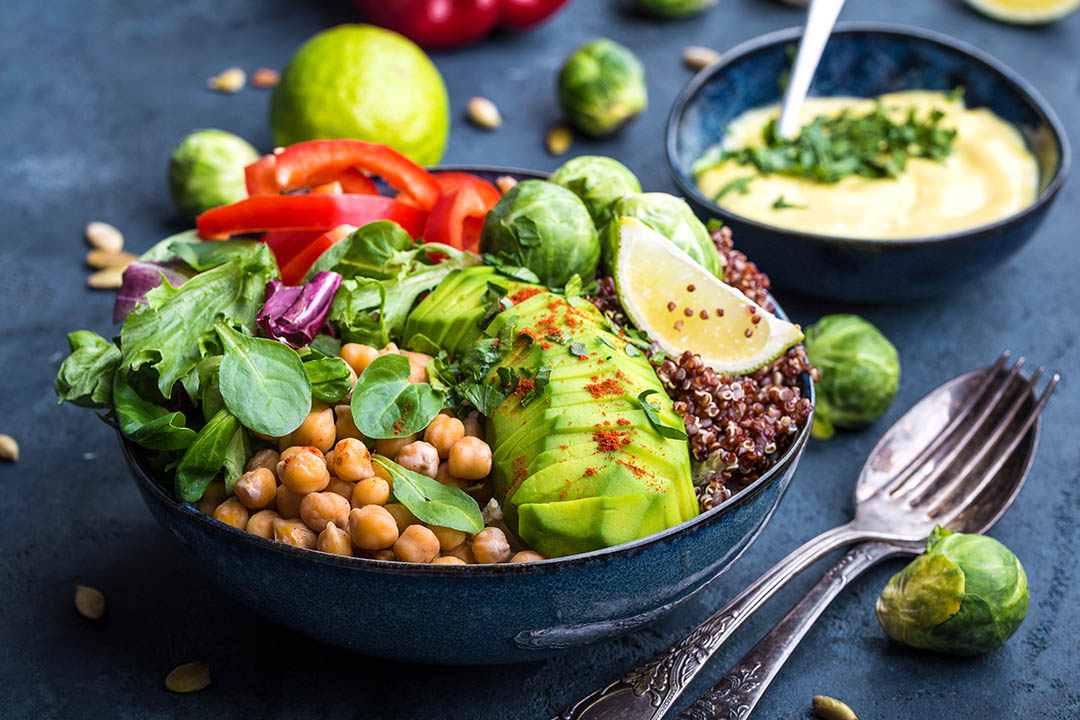
01 Jul Four Tips to Boost Your Digestive Enzymes
Four Tips to Boost Your Digestive Enzymes
by Ashleigh Feltham, Accredited Practising Dietitian and Accredited Nutritionist.
Did you know that you can influence how many digestive enzymes your body produces through your diet choices? It can be beneficial to take specific enzymes for certain conditions, such as exocrine pancreatic insufficiency or lactose intolerance. However, there is little evidence to support taking a general digestive enzyme supplement to help manage gut symptoms.
The best way to optimise the variety and number of digestive enzymes in your system is as simple as making smart diet choices. Here are four top tips to optimise your digestive enzymes.

1. Aim for 30 Different Plant-Based Whole Foods Each Week
Gut microbes have the important job of producing digestive enzymes. Your health-promoting microbes feed off the plant-based foods in your diet. Each type of microbe has a unique fuel requirement. Including a variety of plant-based foods in your diet supports these different types of microbes. Research suggests that including 30 different types of plant-based foods is optimal for supporting a variety and volume of health-promoting microbes.
Plant-based whole foods include wholegrains like wholegrain pasta, couscous, bread and crackers, brown, red or black rice, oats and quinoa. They also include nuts, seeds, vegetables, fruit, legumes and beans. Aim for half of your snacks and half to three-quarters of your meals to consist of plant-based foods.
2. Include a Variety of Fermented Foods Each Day
Fermented foods, such as kefir, yoghurt, sauerkraut and kimchi, are rich in probiotics. The number of enzymes produced in your body will naturally increase when you add a good amount of different kinds of probiotics to your gut.
3. Take Time to Chew Your Food Properly
Chewing stimulates saliva production. There is a digestive enzyme in saliva called amylase, which helps to digest carbohydrates. So it pays to take the time to chew your food properly.
4. Consume Foods That Help Digestion
Including foods that contain enzymes, or that help to stimulate enzymes, such as banana, avocado, honey, papaya and pineapple, may help increase digestive enzymes in your system. Further research is still needed in this area, but current findings look promising.

Take-home message:
Simple lifestyle choices can help to optimise your digestive function, and therefore your health. Try these four diet and lifestyle tips to help optimise the volume and variety of digestive enzymes in your system.
References:
- Gorbach SL. Microbiology of the Gastrointestinal Tract. In: Baron S, editor. Medical Microbiology. 4th edition. Galveston (TX): University of Texas Medical Branch at Galveston; 1996. Chapter 95.
- McDonald D, Hyde E, Debelius JW, Morton JT, Gonzalez A, Ackermann G, Aksenov AABehsaz B, Brennan C, Chen Y, DeRight Goldasich L, Dorrestein PCDunn RR, Fahimipour AK, Gaffney J, Gilbert JAGogul G, Green JL, Hugenholtz P, Humphrey G, Huttenhower CJackson MA, Janssen S, Jeste DVJiang L, Kelley ST, Knights DKosciolek T, Ladau J, Leach J, Marotz C, Meleshko D, Melnik AVMetcalf JL, Mohimani H, Montassier ENavas-Molina J, Nguyen TTPeddada S, Pevzner PPollard KS, Rahnavard GRobbins-Pianka A, Sangwan N, Shorenstein J, Smarr LSong SJ, Spector T, Swafford AD, Thackray VG, Thompson LRTripathi A, Vázquez-Baeza Y, Vrbanac A, Wischmeyer PWolfe E, Zhu Q, , Knight R 2018. American Gut: an Open Platform for Citizen Science Microbiome Research. mSystems 3:10.1128/msystems.00031-18.
- Joubert M, Septier C, Brignot H, Salles C, Panouillé M, Feron G, Tournier C. Chewing bread: impact on alpha-amylase secretion and oral digestion. Food Funct. 2017 Feb 22;8(2):607-614. doi: 10.1039/c6fo00963h. PMID: 27966720.
- Tursi JM, Phair PG, Barnes GL. Plant sources of acid stable lipases: potential therapy for cystic fibrosis. J Paediatr Child Health. 1994 Dec;30(6):539-43. doi: 10.1111/j.1440-1754.1994.tb00730.x. Erratum in: J Paediatr Child Health. 1995 Aug;31(4):364. doi: 10.1111/j.1440-1754.1995.tb00832.x. PMID: 7865271.
- Bassinello PZ, Cordenunsi BR, Lajolo FM. Amylolytic activity in fruits: comparison of different substrates and methods using banana as model. J Agric Food Chem. 2002 Oct 9;50(21):5781-6. doi: 10.1021/jf011370p. PMID: 12358438.
- Burlando B, Cornara L. Honey in dermatology and skin care: a review. J Cosmet Dermatol. 2013 Dec;12(4):306-13. doi: 10.1111/jocd.12058. PMID: 24305429.
- Stremnitzer C, Manzano-Szalai K, Willensdorfer A, Starkl P, Pieper M, König P, Mildner M, Tschachler E, Reichart U, Jensen-Jarolim E. Papain Degrades Tight Junction Proteins of Human Keratinocytes In Vitro and Sensitizes C57BL/6 Mice via the Skin Independent of its Enzymatic Activity or TLR4 Activation. J Invest Dermatol. 2015 Jul;135(7):1790-1800. doi: 10.1038/jid.2015.58. Epub 2015 Feb 23. PMID: 25705851; PMCID: PMC4471117.
- Pavan R, Jain S, Shraddha, Kumar A. Properties and therapeutic application of bromelain: a review. Biotechnol Res Int. 2012;2012:976203. doi: 10.1155/2012/976203. Epub 2012 Dec 10. PMID: 23304525; PMCID: PMC3529416.
